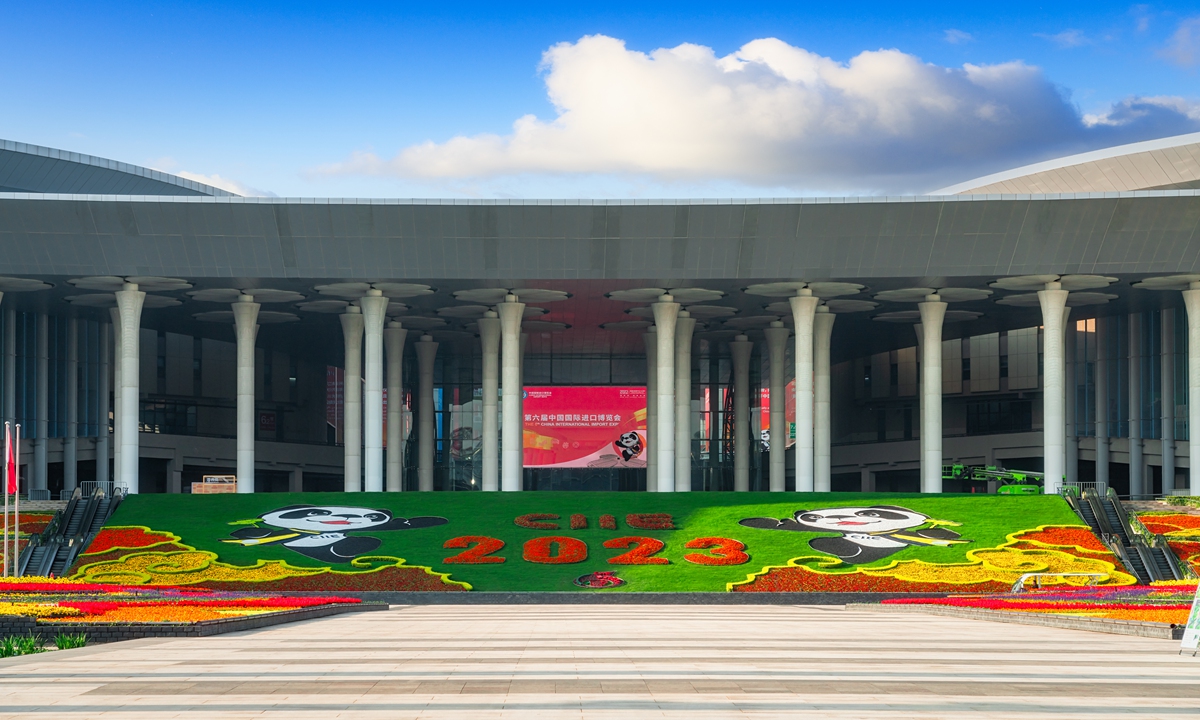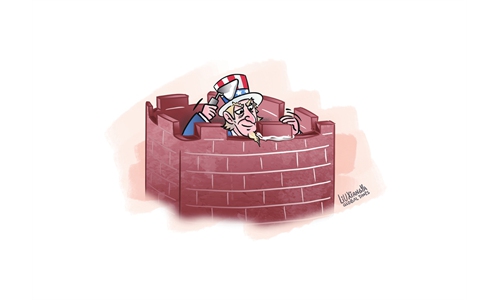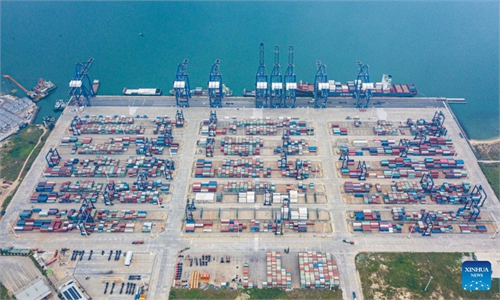China’s attractiveness to foreign investment still has bright spots despite global economic headwinds: EY China chairman
Providing opportunities for countries to jointly promote ‘re-globalization’ of the world economy


A view of the National Exhibition and Convention Center (Shanghai), the main venue for the 6th China International Import Expo (CIIE), in East China's Shanghai Photo: VCG
Editor's Note: In the face of challenges posed by growing anti-globalization and "decoupling," China International Import Expo (CIIE), the world's largest import fair, returns to full strength this year, reaffirming China's commitment for high-level opening-up. The trade fair showcases China's welcoming attitude toward the inflow of global investment and resources and willingness to share its growth dividends from development. The contract amounts of many companies have reached new highs. Jack Chan (Chan), EY China Chairman, EY Greater China Regional Managing Partner, who oversees EY's business functions in the Chinese mainland, Hong Kong, Macao and Taiwan, shared his perspective with the Global Times (GT) on the role of the trade fair in boosting foreign trade and its potential impact on the fourth-quarter trade performance.
GT: What role do you think the CIIE plays in boosting China's foreign trade?
Chan: The CIIE plays a positive role in promoting the development of foreign trade. It not only demonstrates China's determination to support economic globalization and promote trade openness, but also effectively stabilizes the foundation of foreign trade and foreign investment. It becomes a benchmark event for international trade and boosts confidence of the world economic recovery.
As the first national-level trade fair with imports as its main theme, the CIIE has become a window for China to build a new development pattern, a platform to promote high-level opening-up, and an international public good shared by the world. It also witnesses the continuous expansion of China's opening-up.
The success of the CIIE is not only reflected in the increase in trade volume, but also in the promotion of trade, industrial upgrading, consumption upgrading, and institutional innovation, continuously releasing the effects of the trade fair.
More and more exhibitors are accelerating their transformation into investors, covering various industries such as healthcare, manufacturing, and consumer goods. They bring in advanced technologies and products from around the world while empowering the development of China's local innovation ecosystem. This provides insights for the transformation and upgrading of China's real economy, and promotes industrial upgrading in the country.
GT: The latest data shows that China's foreign trade further stabilized in September and October. Will the CIIE lead to further positive performance in the fourth quarter trade?
Chan: China's foreign trade is expected to continue its stable and positive momentum with the joint efforts of various parties, and the hosting of events such as the CIIE will create more opportunities and room for foreign trade development.
In the first three quarters of this year, China's foreign trade maintained steady growth, with the year-on-year growth rate remaining stable. In September, it reached a new high for the year. In the fourth quarter, with the implementation of various policy stimuli and proactive efforts by the private sector, coupled with the slower growth rate last year, China's foreign trade is expected to gradually improve on a year-on-year basis. The decline in export volume compared to the previous year is expected to continue to narrow in the coming months.
The intensive hosting of trade fairs such as the CIIE and the Canton Fair may have a positive impact on the performance of foreign trade. Firstly, these exhibitions provide a cooperation platform for domestic and foreign companies, helping to expand markets and further enhance the international reputation and competitiveness of Chinese products and services. Secondly, the exhibitions can facilitate the connection between domestic and foreign trade, strengthening communication between supply and demand, and facilitating trade activities. Additionally, the trade fairs have a ripple effect, driving the development of related industry chains.
GT: What changes do you think will occur in China's import and export in the service sector as well as its drive to attract foreign investment?
Chan: The long-term trend of attracting foreign investment in China remains positive, with continued growth in service trade and potential for further development driven by knowledge-intensive industries. The high-quality development of the Belt and Road Initiative (BRI) cooperation is also expected.
The global economic recovery faces challenges, but as of now, China's attraction of foreign investment still has bright spots. The number of newly established foreign-funded enterprises has grown rapidly, the investment structure has continued to optimize, and some developed economies have increased their investment in China, reflecting the continued optimism of foreign investors in the investment prospects in China.
China's service sector is recovering well, with an increase in the proportion of knowledge-intensive service trade and a faster recovery in travel-related consumption. In the first eight months of this year, the import and export of knowledge-intensive services increased by 10.4 percent year-on-year, accounting for 42.6 percent of the total service import and export; travel services continued to recover with a year-on-year growth of 69.5 percent, making it the fastest-growing sector in service trade.
In terms of specific service industries, the modern service sector has remained active in the first three quarters of 2023, with the rapid development of new service formats and promising growth in emerging service sectors. With industrial and consumption upgrades, coupled with the effects of policies promoting consumption and investment, the potential for service sector consumption is expected to continue to be unleashed.
Additionally, infrastructure investment is expected to accelerate, and high-tech and private manufacturing industries will support faster growth in manufacturing investment, thereby enhancing the internal growth momentum of the economy.
This year marks the 10th anniversary of the BRI, and China's trade structure, scale, and volume with countries participating in the initiative have significantly enhanced. At the recently concluded third Belt and Road Forum for International Cooperation, China announced eight major steps to support high-quality Belt and Road cooperation, including the construction of a multidimensional interconnectivity network and the support for an open world economy.
In October, EY released Navigator series Special Edition for the 10th Anniversary of the Belt and Road Initiative which showed that green and digital have become key words for Chinese enterprises participating in international cooperation and implementing the "dual circulation" strategy, providing opportunities for China and BRI partner countries to jointly promote "re-globalization" of the world economy.
GT: How do you view the future development trend of the Chinese economy? Do you think China can achieve a growth rate of around 5 percent this year? Why?
Chan: China's economy has shown strong resilience, great potential, and vitality, and its long-term positive fundamentals remain unchanged. This year, China's economic growth has recovered amidst fluctuations, with a year-on-year increase of 5.2 percent in GDP in the first three quarters. This has laid a solid foundation for achieving the target of around 5 percent growth for the whole year. Considering the robust growth of China's economy and its resilience in global economic activities, there is confidence in achieving the 5 percent growth target for China's economy this year.
In terms of consumption, domestic demand in China continues to expand, driving economic growth. Since the beginning of this year, the potential for household consumption has gradually been unleashed, with final consumption expenditure contributing 83.2 percent to economic growth in the first three quarters, a significant increase.
Currently, the recovery of the domestic economy will still rely more on domestic demand. The accelerated release of policies to promote consumption is expected to maintain a moderate recovery. As for attracting foreign investment, China has been rising to the challenge and has made breakthroughs in both quantity and quality. With the gradual implementation of a series of policies and measures to stabilize growth, the positive effects will continue to be seen. Furthermore, investment in high-tech industries will further contribute to the high-quality development of the economy.
GT: China has just announced the complete removal of investment restrictions on foreign capital in the manufacturing sector. In which areas do you believe this will bring further opportunities for foreign investment?
Chan: China has just completely lifted the investment restrictions on foreign capital in the manufacturing sector, which is believed to further promote foreign investment in several aspects. This measure signifies China's further opening-up of the manufacturing sector, which is not only necessary for the development of China's manufacturing industry but also sends an important signal of economic transformation.
It demonstrates the significant role of manufacturing and the real economy in the national economy, while showcasing China's determination for high-level opening-up to the outside world. For enterprises and industrial development, the most direct effect of opening-up is the introduction of more funds, products, technologies, and management experience. It also allows for the introduction of competition or cooperation mechanisms, enabling domestic enterprises to make greater innovation efforts, enhance industry vitality, provide better products and services to consumers through industry competition, and strengthen the international competitiveness of enterprises.
The favorable policy environment and vast market will attract more high-quality multinational manufacturing industries to enter the domestic market, further promoting the upgrading of China's manufacturing industry. Furthermore, this policy indicates the further optimization of the business environment. Behind the opening-up, there is a need for a series of policies to optimize the business environment, creating a more favorable development environment for more global elements to enter the Chinese market.



